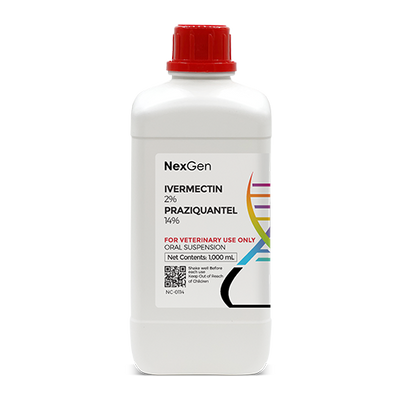
Ivermectin 2% + Praziquantel 14%, Oral Suspension, 500mL
Login for pricing
- Brand
- Mixlab
- SKU:
- NC-0451
- Product Type:
- Suspension
- Size:
- 500ml
- Administration:
- Oral
All horses are susceptible to worm infestations, and it is reasonable to assume that most horses will have a certain degree of parasitic load, regardless of how carefully a horse is dewormed.1 In most cases, parasites do not cause clinical disease in horses; thus, the literature suggests that rendering a horse parasite-free cannot and should not be the goal of any deworming program. The presence of endoparasites (parasites that live inside the horse) are a common phenomenon of horse management.2 When parasite loads become too heavy however, they can result in reduced feed utilization, reduced feed intake, and a low body condition score. In certain cases, parasites can contribute to the incidence of colic in foals and older horses.1,3
Worms Affecting Horses
The most significant internal parasites which infest horses are strongyles, ascarids, pinworms and bots. The digestive tract (or stomach and intestines) is the most commonly affected, along with migration through other tissues and organs such as the heart, liver, lungs, and blood vessels.1
Small Redworms (Cyathostomes) These are the most common internal parasite of horses. They produce larvae that hibernate in the gut wall during the winter and emerge in large numbers as adults in the spring, causing severe damage to the intestines.1 Cyathostomes can cause weight loss, diarrhea and colic with potentially fatal consequences, particularly at the time of emergence.1
Large Redworms (Strongyles) Large redworms (e.g., Strongylus vulgaris, S. edentatus and S. equinus) are among the most dangerous internal parasites of horses.1 Their life cycle includes a larval stage during which they migrate in the blood vessels and can cause anemia and blood clots. They can eat through the lining of the gut wall and travel through the blood vessels of the gut, causing significant bleeding. Severe cases can lead to the death of the horse.
Ascarids are not usually a problem in adult horses however, foals can be vulnerable to ascarid infections and should be dewormed against them at two to three months of age, and again at six months.2 Ascarids (Parascaris equorum) are very large worms measuring as much as 15 inches. Adult worms live curled up within the small intestine. Ascarid infection is associated with chronic diarrhea and subnormal growth, which is caused by the ascarid interfering with nutrient digestion and absorption.
Stomach bots are the larvae of the adult bot fly (Gasterophilus sp.). There are three primary species in North America, which can be identified by the body part of the horse upon which they lay their eggs. G. intestinalis lays eggs on the shoulders and forelimbs; the larvae are signalled to hatch by the horse’s warm lips and breathe coming into contact with them. G. nasalis deposits its eggs on the hairs of the space between the jawbones, while G. hemorrhoidalis lays its eggs on the hairs that adjoin the lips. These species hatch outside the horse and enter the horse’s mouth as the horse licks them. Once inside the mouth, they burrow into the pockets between the molar teeth and develop for a period of weeks.1 The second larval stage is swallowed, and the larvae attach themselves to the lining of the stomach. The final stage larva attaches itself to the lining of the small intestine and waits until spring, when they are passed out with the horse’s feces.
Tapeworms that affect horses are represented by three species. Their intermediate state grows inside a grass mite which climbs onto pasture grasses where they are eaten by the horse. The immature tapeworm matures inside the horse, after which it attaches to the lining of the small intestine. Tapeworms are reported in at least 50% of grazing horses, and usually do not cause clinical disease. In weanlings or older horses however, tapeworm infections can be associated with colic, unthriftiness and weight loss.1,2 Many horse deworming regimens include dosing with ivermectin/praziquantel once per year, usually in the fall.
Ivermectin + Praziquantel for Worms in Horses
Ivermectin is a mixture of two structurally semisynthetic lactones that is used in veterinary medicine as an anthelmintic, boticide, acaricide, and insecticide. Ivermectin has a broad spectrum of activity against intestinal and insect parasites, and kills migrating larvae.3
Praziquantel is an anticestodal anthelmintic that is useful in the treatment of other parasites.
Where to buy Ivermectin + Praziquantel
Ivermectin + Praziquantel is available in the U.S. through several pharmaceutical manufacturers and through veterinary custom compounding companies.
This product carries several potential drug interactions. Please consult your veterinarian prior to beginning any treatment regimen.
FOR RX ONLY: A valid prescription from a licensed veterinarian is required for dispensing this medication.
1Nielsen, M., et. al. Handbook of Equine Parasite Control, Second Edition. March 2018, John Wiley & Sons, Inc.
2Saeed, M.A., Beveridge, I., Abbas, G. et al. Systematic review of gastrointestinal nematodes of horses from Australia. Parasites Vectors 12, 188 (2019).

















